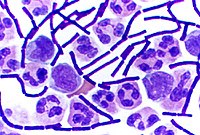
Photo from wikipedia
The presence of Gram-positive bacteria in foodstuffs is a chronic worldwide problem. Here, we present a cheap and simple colorimetric method for the detection of Lactobacillus species (spp.) and Staphylococcus… Click to show full abstract
The presence of Gram-positive bacteria in foodstuffs is a chronic worldwide problem. Here, we present a cheap and simple colorimetric method for the detection of Lactobacillus species (spp.) and Staphylococcus aureus (S. aureus) using gold nanoparticles (AuNP) modified with monoclonal anti-Gram-positive bacteria to produce an immune-sensor. Detection is based on the fact that antibody-conjugated AuNPs can readily identify Gram-positive bacteria through antibody-antigen recognition, which results in a color change of AuNPs upon aggregation. The detection limit was 105CFU/ml in pure culture for Lactobacillus spp. and 120CFU/ml in pure culture for S. aureus. The method was applied successfully for detection of bacteria in samples of sugar cane, and agreed well with values obtained using other methods. These results suggested that the detection system could be used for the quantitative analysis of Gram-positive bacteria and might be applied potentially by the food industry.
Journal Title: Food chemistry
Year Published: 2017
Link to full text (if available)
Share on Social Media: Sign Up to like & get
recommendations!